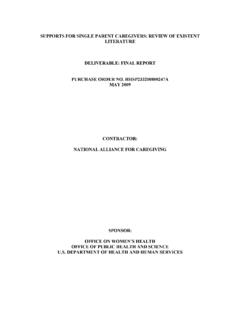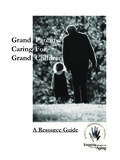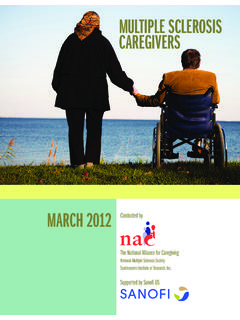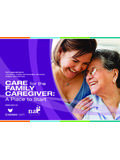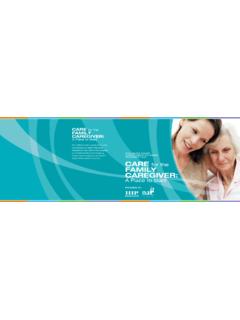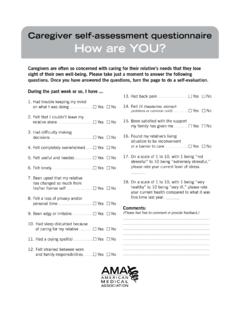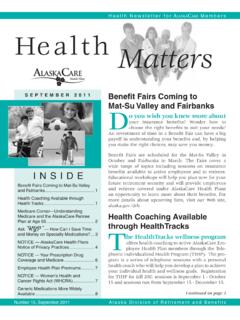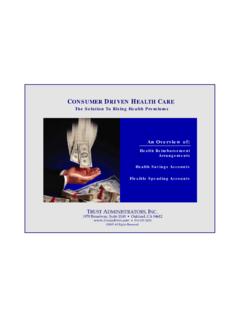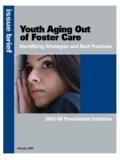Transcription of The MetLife Study of Caregiving Costs to Working ...
1 Mature MarketINSTITUTE The MetLife Study ofCaregiving Costs to Working CaregiversDouble Jeopardy for Baby Boomers Caring for Their ParentsJune 2011 STUDYThe MetLife Study of Caregiving Costs to CaregiversThe MetLife Mature Market Institute The MetLife Mature Market Institute is MetLife s center of expertise in aging, longevity and thegenerations and is a recognized thought leader by business, the media, opinion leaders and thepublic. The Institute s groundbreaking research, insights, strategic partnerships and consumereducation expand the knowledge and choices for those in, approaching or Working with themature market. For more information, please visit: 57 Greens Farms RoadWestport, CT 06880(203) Alliance for CaregivingEstablished in 1996, The National Alliance for Caregiving is a non-profit coalition of national or-ganizations focusing on issues of family Caregiving .
2 The Alliance was created to conduct re-search, do policy analysis, develop national programs, and increase public awareness of familycaregiving issues. Recognizing that family caregivers make important societal and financial con-tributions toward maintaining the well-being of those for whom they care , the Alliance s mis-sion is to be the objective national resource on family Caregiving with the goal of improvingthe quality of life for families and care Montgomery Lane, Suite 205 Bethesda, MD for Long Term care Research and Policy, New York Medical CollegeThe Center for Long Term care Research and Policy at the School of Health Sciences and Prac-tice, New York Medical College, was established to engage in research, education and publicpolicy development to improve long term care for all Americans. The Center s work focuses onhealth care disparities, health care needs and Caregiving across the lifespan and to promote fairand equitable financing of long-term care in the United States.
3 Research and analysis in this re-port is provided by Peter S. Arno, PhD, and Deborah Viola, PhD with statistical support fromQiuhu Shi, for Long Term care Research and PolicySchool of Health Sciences and PracticeNew York Medical College, Valhalla NY 2011 MetLife Not A Deposit Not FDIC-Insured Not Insured By Any Federal Government Agency Not Guaranteed By Any Bank Or Credit Union May Go Down In Value 2 Executive Summary2 Key Findings4 Introduction4 What Do We Already Know About Working Caregivers?5 Research Questions About Caregivers6 Major Findings6 Profile of Parental Caregivers 10 Cost to Caregivers in Lost Wealth 15 Other Financial and Health Impacts 18 Implications18 Implications for Caregivers18 Implications for Employers19 Implications for Policymakers20 Methodology21 Appendix21 Respondent Demographics22 EndnotesTable of ContentsExecutive Summary2 Nearly 10 million adult children over the age of 50 care for their aging family caregivers are themselves aging as well as providing care at a timewhen they also need to be planning and saving for their own retirement.
4 TheMetLife Study of Caregiving Costs to Working Caregivers: Double Jeopardy forBaby Boomers Caring for Their Parents was produced by the MetLife MatureMarket Institute in partnership with the National Alliance for Caregiving and the Center for Long Term care Research and Policy at New York Medical Study analyzes data from the 2008 panel of the National Health andRetirement Study (HRS) combined with estimates to determine the extent towhich older adult children provide care to their parents, the roles gender andwork play in that Caregiving , and the potential cost to the caregiver in lostwages and future retirement income as a result of their Findings The percentage of adult children providing personal care and/or financialassistance to a parent has more than tripled over the past 15 years. Currently,a quarter of adult children, mainly Baby Boomers, provide these types of careto a parent.
5 The total estimated aggregate lost wages, pension, and Social Securitybenefits of these caregivers of parents is nearly $3 trillion. For women, the total individual amount of lost wages due to leaving thelabor force early because of Caregiving responsibilities equals $142,693. Theestimated impact of Caregiving on lost Social Security benefits is $131,351. A very conservative estimated impact on pensions is approximately $50, , in total, the cost impact of Caregiving on the individual female caregiverin terms of lost wages and Social Security benefits equals $324,044. For men, the total individual amount of lost wages due to leaving the labor force early because of Caregiving responsibilities equals $89,107. Theestimated impact of Caregiving on lost Social Security benefits is $144, in a conservative estimate of the impact on pensions at $50,000, thetotal impact equals $283,716 for men, or $303,880 for the average male orfemale caregiver 50+ who cares for a parent.
6 Working and non- Working adult children are almost equally as likely toprovide care to parents in need. Overall, Caregiving sons and daughters provide comparable care in manyrespects, but daughters are more likely to provide basic care and sons aremore likely to provide financial assistance. Adult children 50+ who work and provide care to a parent are more likely tohave fair or poor health than those who do not provide care to their the long-term financial impact of Caregiving for aging parents on care -givers themselves, especially those who must curtail their Working careers to doso, is especially important, since it can jeopardize their future financial is also evidence that caregivers experience considerable health issues as aresult of their focus on caring for others. The need for flexibility in the work-place and in policies that would benefit Working caregivers are likely to increasein importance as more Working caregivers approach their own retirement whilestill caring for an aging parent.
7 3> Caregiving Costs to Working Caregivers4 IntroductionWhat Do We Already Know About Working Caregivers?The rising demand for Caregiving services will undoubtedly grow with the agingof the Baby Boomers as the population continues to become older forseveral decades to come. Women s participation in the labor force, particularly by women age 55 andolder, has increased dramatically more than 50% in the past 15 years1 whilegrowth in household incomes has leveled off. As a result, the economic burdenof caring for family members is rising. In addition, family caregivers are aging as well. Many studies have found that stress, time away from family/friends,increased medication use, lost time at work, misuse of alcohol or prescriptiondrugs, incidence of coronary heart disease, and depression are all negativelyassociated with family Study is an updated, national look at adult children who work and care for their parents.
8 Prior reports, including the MetLife studies Sons at Work:Balancing Employment and Eldercare2and The MetLife Juggling Act Study :Balancing Caregiving with Work and the Costs Involved,3have considered theimpact on adult children who balance work and family Caregiving . The MetLifeStudy of Caregiving Costs to Working Caregivers: Double Jeopardy for BabyBoomers Caring for Their Parents focuses on caregivers who are adult childrenover the age of 50, by work status and gender, to consider the impact of caringfor parents on the Baby Boomer generation. Approximately million adultchildren over the age of 50 care for their parents,4which suggests that familycaregivers are themselves aging and yet are providing care at a time when theyalso need to plan and save for their own retirement. These factors are especiallyimportant as workers emerge from the economic recession in the and itsimpact on their future financial Questions About CaregiversThis Study analyzes data from the 2008 panel of the Health and Retirement Study (HRS), combined with estimates from other recognized studies, to answerquestions regarding the extent to which older adult children provide personalcare and financial assistance to their parents, the roles that gender and work playin this Caregiving , and the potential financial impact on the Working caregiver.
9 Specifically, the Study focuses on the economic transfers, in terms of time andmoney, that can result from Caregiving . Included in the definition of economictransfer is the impact of Caregiving on caregivers wages, Social Security savings,and retirement income. This is in addition to economic transfers that these sameadults may also be making to their children who need financial assistance andsupport with college, mortgages, and grandchildren expenses, but that is out-side the scope of this Caregiving Study addresses the following there differences between adult Caregiving children who work and thosewho do not? there gender differences in the economic burden? is the economic impact of family Caregiving on these 50+ caregivers? might these Study findings influence policy or practice? 5> Caregiving Costs to Working Caregivers6 Profile of Parental CaregiversThe Health and Retirement Study (HRS) was first fielded in 1992.
10 The nationallyrepresentative HRS surveys adults over the age of 50 every two years and providesextensive information on this population, including data on income, work, andhealth status, and whether respondents provide personal care and/or financialassistance to their parents. This sample was restricted to HRS respondents from the2008 panel who had a living parent. The sample contained 1,112 men and womenwith at least one parent living. (Additional information regarding this sample isavailable in the Appendix.) Caregiving activity can take many forms. Basic care in the HRS is defined aspersonal activities like dressing, feeding, and bathing, or what are more commonlyreferred to as activities of daily living (ADLs) or personal care . These caregivingtasks are usually viewed as more intensive (and stressful) than instrumentalactivities of daily living, such as grocery shopping, transportation, and handlingfinances which were not asked of caregivers in the HRS sample.


